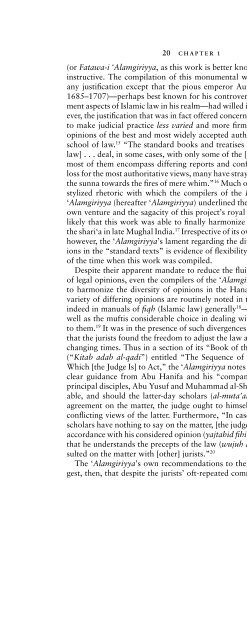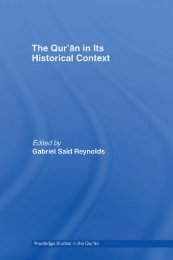Download (1 MB) - Islam and Christian-Muslim Relations: Articles ...
Download (1 MB) - Islam and Christian-Muslim Relations: Articles ...
Download (1 MB) - Islam and Christian-Muslim Relations: Articles ...
Create successful ePaper yourself
Turn your PDF publications into a flip-book with our unique Google optimized e-Paper software.
20 CHAPTER 1(or Fatawa-i ‘Alamgiriyya, as this work is better known in South Asia) isinstructive. The compilation of this monumental work scarcely neededany justification except that the pious emperor Aurangzeb ‘Alamgir (r.1685–1707)—perhaps best known for his controversial efforts to implementaspects of <strong>Islam</strong>ic law in his realm—had willed it. Significantly, however,the justification that was in fact offered concerned precisely the needto make judicial practice less varied <strong>and</strong> more firmly entrenched in theopinions of the best <strong>and</strong> most widely accepted authorities in the Hanafischool of law. 15 “The st<strong>and</strong>ard books <strong>and</strong> treatises of this discipline [oflaw] . . . deal, in some cases, with only some of the [legal] problems, <strong>and</strong>most of them encompass differingreports <strong>and</strong> conflictingproofs”; at aloss for the most authoritative views, many have strayed from the “light ofthe sunna towards the fires of mere whim.” 16 Much of this is undoubtedlystylized rhetoric with which the compilers of the Fatawa al-Hindiyya/‘Alamgiriyya (hereafter ‘Alamgiriyya) underlined the significance of theirown venture <strong>and</strong> the sagacity of this project’s royal patron; <strong>and</strong> it is unlikelythat this work was able to finally harmonize the legal practice ofthe shari‘a in late Mughal India. 17 Irrespective of its own success or failure,however, the ‘Alamgiriyya’s lament regarding the diversity of legal opinionsin the “st<strong>and</strong>ard texts” is evidence of flexibility in the legal practiceof the time when this work was compiled.Despite their apparent m<strong>and</strong>ate to reduce the fluidity (or uncertainty)of legal opinions, even the compilers of the ‘Alamgiriyya did little to tryto harmonize the diversity of opinions in the Hanafi legal tradition. Avariety of differingopinions are routinely noted in this compilation—asindeed in manuals of fiqh (<strong>Islam</strong>ic law) generally 18 —giving the judges aswell as the muftis considerable choice in dealingwith the cases broughtto them. 19 It was in the presence of such divergences of opinion (ikhtilaf)that the jurists found the freedom to adjust the law <strong>and</strong> its application tochanging times. Thus in a section of its “Book of the Judge’s Etiquette”(“Kitab adab al-qadi”) entitled “The Sequence of Proofs accordingtoWhich [the Judge Is] to Act,” the ‘Alamgiriyya notes the view that shouldclear guidance from Abu Hanifa <strong>and</strong> his “companions” (viz., his twoprincipal disciples, Abu Yusuf <strong>and</strong> Muhammad al-Shaybani) not be available,<strong>and</strong> should the latter-day scholars (al-muta’akhkhirun) be in disagreementon the matter, the judge ought to himself choose among theconflictingviews of the latter. Furthermore, “In case even the latter-dayscholars have nothingto say on the matter, [the judge] exercises ijtihad inaccordance with his considered opinion (yajtahid fihi bi-ra’yihi), providedthat he underst<strong>and</strong>s the precepts of the law (wujuh al-fiqh) <strong>and</strong> has consultedon the matter with [other] jurists.” 20The ‘Alamgiriyya’s own recommendations to the judges seem to suggest,then, that despite the jurists’ oft-repeated commitment to the most



